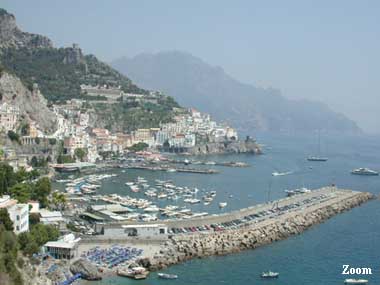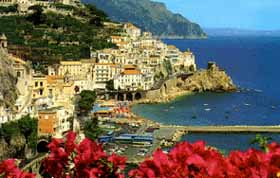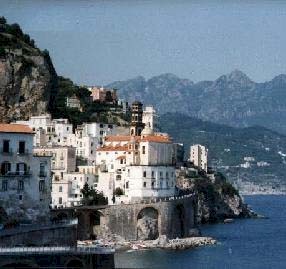|
 アマルフィ海岸は変化に富んだ地形が延々36kmも続く美しい地域です。この地域を特徴づけているのは、大自然と、独特な建築、キリスト教信仰にアラブ様式を取り入れた文化、航海士や芸術家、聖人たちにまつわる歴史です。不滅の弁証理論の西と東の境界線となっていたこの地域は、訪れる人々を今も昔も変わらず非日常の世界へといざなってくれます。明るい太陽ときれいな海、澄んだ空気につつまれたアマルフィ海岸は、世界を舞台に活躍する人たちにも愛されています。アマルフィ海岸は大小の入り江からなるリアス式海岸で、その曲がりくねった海岸線はどこもそれぞれの表情を持っています。 アマルフィ海岸は変化に富んだ地形が延々36kmも続く美しい地域です。この地域を特徴づけているのは、大自然と、独特な建築、キリスト教信仰にアラブ様式を取り入れた文化、航海士や芸術家、聖人たちにまつわる歴史です。不滅の弁証理論の西と東の境界線となっていたこの地域は、訪れる人々を今も昔も変わらず非日常の世界へといざなってくれます。明るい太陽ときれいな海、澄んだ空気につつまれたアマルフィ海岸は、世界を舞台に活躍する人たちにも愛されています。アマルフィ海岸は大小の入り江からなるリアス式海岸で、その曲がりくねった海岸線はどこもそれぞれの表情を持っています。 光あふれる海岸の景色は、普段あわただしく日常を過ごしている旅行者たちの心を動かしてうっとりとした陶酔の世界に連れて行ってくれるでしょう。 光あふれる海岸の景色は、普段あわただしく日常を過ごしている旅行者たちの心を動かしてうっとりとした陶酔の世界に連れて行ってくれるでしょう。
この地方では、海と山、農業と観光とは共通点を持ちながらもそれぞれの違いを引き立てあう役割を果たしており、それがこの地域の特徴となっています。アマルフィ共和国の豊かな輝かしい歴史、中世の町並みや豊富な遺跡、レモンやブドウの畑、樫や栗の木の緑などはこの地方の財産であり、これからも大切にしていかなければなりません。
 この夢のような環境にあって、人々は手漉き紙や陶器、栗かご、錬鉄、「モーダ・ポジターノ」等の手工芸分野でその感性や創造性を表現しています。 この夢のような環境にあって、人々は手漉き紙や陶器、栗かご、錬鉄、「モーダ・ポジターノ」等の手工芸分野でその感性や創造性を表現しています。
人々は昔も今も変わらず勤勉かつ独創的に伝統を受け継いできました。環境を損なうことなく、これまで大切に受け継いできたものを生活や文化や観光の中で本当に役立てていくことこそが自らの務めと考えているのです。典型的な修道院料理や健康的な家庭料理など伝統の食生活の中にも新しい発見があります。
完璧な美しさを誇るこの海岸を米国の詩人ロングフェローはこう読んでいます。「・・・海より出で立つ大地、山と波が出会う場所」
|
Cathedral of Sant' Andrea Sorrento and Amalfi Coast
Taken in Positano, where you can see the church's dome and bougainville, which covered almost every roof, house and wall of the village On the famous Amalfi Coast, the village of Amalfi stands out as a beacon of beauty and refinement. An independent republic from the seventh century until 1075, it rivalled Pisa and Genoa in its domestic prosperity and maritime importance. It was then an independent republic with a population of some 70,000, reaching an apogee about the turn of the first millennium.
Amalfi is the main town of the coast on which it is located, named Costiera Amalfitana, and is today an important tourist destination together with other towns on the same coast, such as Positano, Praiano, Ravello and others. Amalfi is included in the UNESCO World Heritage Sites.
The Amalfi coast is famed for its production of Limoncello liqueur and home-made paper used throughout Italy for wedding invitations, visiting cards and elegant writing paper. The Catholic Encyclopedia notes that Saint Andrew's relics were brought from Constantinople to Amalfi in Campania, by the Amalfitan Pietro, cardinal of Capua, in 1210 after the completion of the town's cathedral. The cathedral, dedicated to St. Andrew (as is the town itself), contains a tomb in its crypt that it maintains still holds a portion of the remains of the body of the apostle. You can also see a golden reliquary which originally housed his skull and another one used to process the bones through Amalfi on holy days. A private little bay where day cruisers enjoy the beautifull scenery of the cliffs and waters of Capri If I'm on an island and I'm looking east towards Sorrento and the Amalfi coast. Capri's famous blue grotto isn't easily accessible, and for 10€ you get a quick (about 2 minute) tour inside in a dingy. Depending upon the tide and the size of the swells pounding the entrance to the grotto, the guides will have passengers lie down while they pull the boat and sightseers into the grotto with a chain permanently attached to the cave entrance.
Inside the grotto the sea seems to be lit from underwater. It is a magnificent blue colour, hence its name. This is due to another opening to the grotto, completely submerged, and the limestone bottom. It allows in sunlight to truly light the water from below. The underground passages leading to the grotto are partially sealed and supposedly once were connected to catacombs of Roman tombs. Beautifull Sorrento has found a way to entertain the desire of it's tourist for a swim and tan, by building these decks just over the rocky shore. are the three stacks (or rocks) that are partially detached from the main island of Capri. The stacks have been given their own names: Stella (still attached to the main island), Mezzo (after Stella), and Scopolo (or Fuori)

Taken in Positano, where you can see the church's dome and bougainville, which covered almost every roof, house and wall of the village
|

















